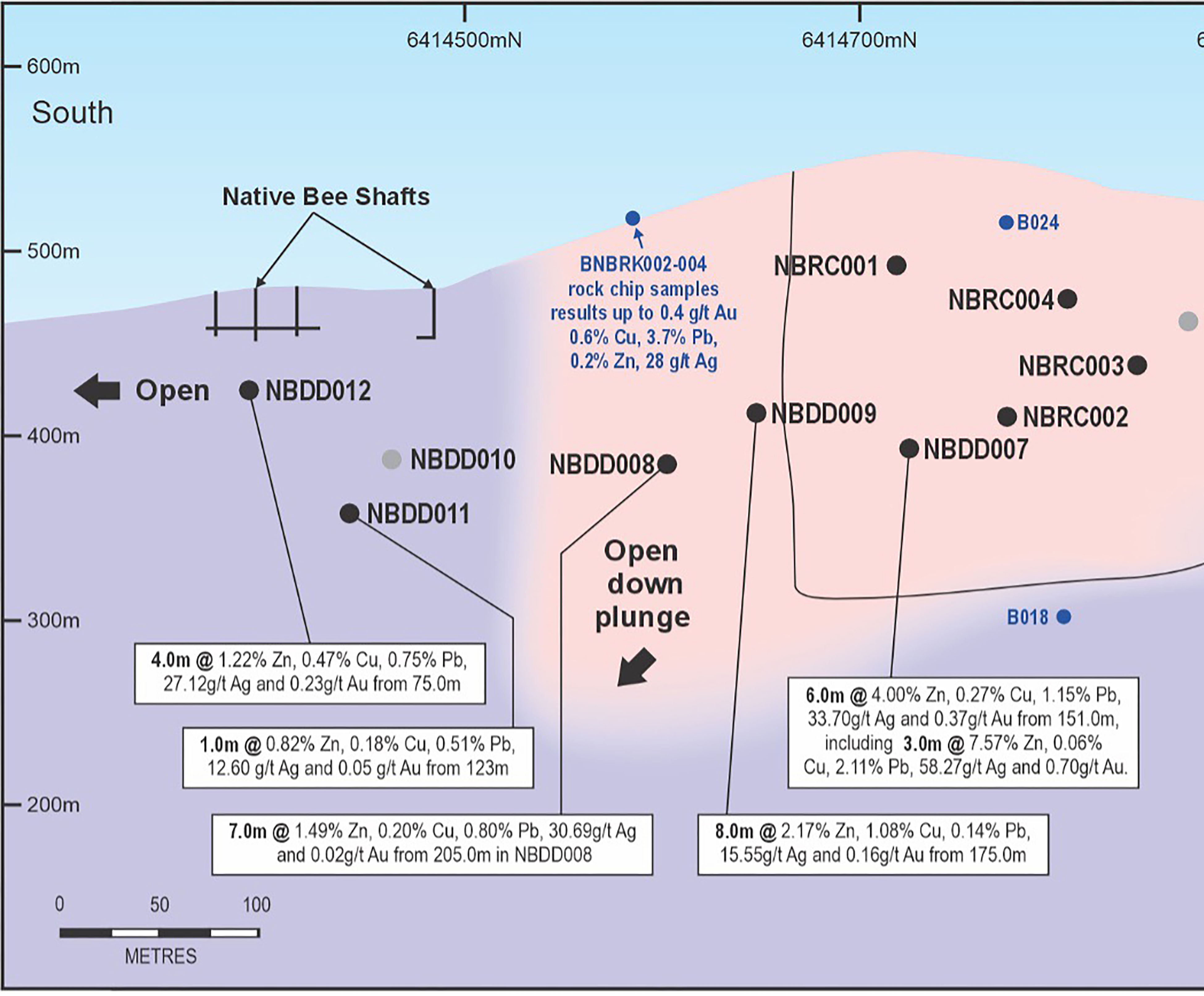Belara NSW

Figure 1 Location of the Belara Project.
Belararox has a 100% interest in the 643 km2 Belara Project located in the Lachlan Fold Belt of New South Wales.
Location
The Belara project is three exploration licences (EL9184, EL9523, EL9538) located between Wellington and Mudgee in Central Western NSW covered by farmland with good road access (Figure 1)
Geology
The project area covers Siluro-Devonian geology of the Hill End Trough (Figure 2), with younger overlying Permian sedimentary rocks, the Mesozoic Mebul alkali diorite, Cenozoic alluvium and basalt, Quaternary alluvium along watercourses, and Quaternary residual and colluvial regolith (Meakin & Morgan 1999). Of primary interest for mineral exploration of the tenement are the Silurian to Carboniferous units (Figure 2), which from oldest to youngest are:

Figure 2 Geology of the Belara project (from Dubbo 1:250 000 Geological Sheet, Morgan et al 1999)
- Siluro-Devonian volcaniclastics, sandstone and siltstone of the Chesleigh Group and Crudine Group,
- Devonian dolerite-diorite sills, and
- Carboniferous granites
The Siluro-Devonian units are deformed by north to north-northwest trending folds and faults and are metamorphosed to mid-greenschist facies (Meakin & Morgan 1999).
Mineralisation
The Belara Project is being explored by Belararox for orogenic mineral systems such as Cobar-type copper (Cu) - gold (Au) - zinc (Zn) - lead (Pb) - silver (Ag) deposits and lode Au deposits (Figure 3). Orogenic mineral systems are described by Geoscience Australia (Huston et al 2023) as being:

Figure 3 Diagrammatic sketch of the orogenic mineral system illustrating the relative location of deposit types within the overall setting and the likely distribution of critical and other commodities within and around these deposit types (Huston et al 2023)
- Associated with orogenic provinces,
- In terranes including those dominated by turbiditic (meta-sedimentary) rocks,
- Associated with second- and third-order faults and shear zones,
- Most common in rocks with a metamorphic grade of low- to mid- greenschist facies, and
- Commonly form during the late stages of orogenesis.
These descriptions match the characteristics of the Belara Project prospective rocks and mineralisation types in the Hill End Trough of the Lachlan Orogen. Both Cobar-type Cu-Au-Zn-Pb-Ag deposits and lode Au deposits are being explored for by Belararox at the Belara Project.
Mineral Resource Estimate
SRK Consulting was contracted by Belararox to complete a Mineral Resource estimation study on the Belara and Native Bee Prospects (refer to ASX announcement of 3/11/2022). The Mineral Resource Estimate is classified in accordance with the JORC 2012 code and has been completed for Belara and Native Bee prospects with Inferred Resources of 5.0 million tonnes (Mt) at 3.41% Zinc equivalent (ZnEq), as shown in Table 1 and in Figures 4 and 5.
 Table 1 Belara Project Inferred Mineral Resource Estimate as at 31 October 2022, reported at various ZnEq cutoffs (SRK, 2022)
Table 1 Belara Project Inferred Mineral Resource Estimate as at 31 October 2022, reported at various ZnEq cutoffs (SRK, 2022)
Reporting Notes:
ZnEq is calculated using 6 month average metal prices from the London Metals Exchange in US$ (Zn 3,596 $/t , Pb 2,089 $/t, Cu 8,633 $/t, Au 1806 $/oz, Ag 21 $/oz) and metallurgical recoveries determined from preliminary metallurgical review and interpretation supplied by Belararox (Zn 74%, Pb 62%, Cu 75%, Au 65%, Ag 45%). ZnEq is calculated by the formula ZnEq = Zn + (Pb*0.48672) + (Cu*2.43317) + (Au*1.30776) + (Ag*0.01133). Grade tonnages are valid for model reporting above 0.85% ZnEq however an economic cutoff of 3% ZnEq could be considered. Rounding may result in minor discrepancies.
Exploration Upside
At Belara, mineralisation is open to the north and down-dip and appear to be increasing at depth (Figures 4 and 5).

Figure 4 Location of Belara Mine showing the location of drill holes included in the 2022 Mineral Resource Estimate and the main zone of mineralisation.

Figure 5 Long section at Belara showing existing drill intersections. High-grade mineralisation remains open at depth to the north.
Significant drill results include:
- 7.0m @ 2.22% Zn, 2.54% Cu (from 78.0m in BLRC013), including 3.0m @ 4.73% Zn, 5.85% Cu (from 78.0m)
- 5.0m @ 6.80% Zn, 1.19% Cu (from 51.0m in BLDD028)
- 4.0m @ 1.46% Zn, 0.70% Cu (from 67.0m in BLRC015)
- 10.0m @ 3.80% Zn, 0.25% Cu (from 81.0m in BLRC019D)
- 8.0m @ 4.17% Zn, 0.45% Cu (from 299.0m in B030)
- 9.0m @ 4.91% Zn, 0.42% Cu (from 307.9m in B021)
- 16.5m @ 2.39% Zn, 0.44% Cu (from 337.0m in B033)
At Native Bee, drill results from the 2023 campaign (Phase 2) focussed on identifying additional mineralisation to the maiden Mineral Resource Estimate and indicate that the mineralisation thickness is increasing at depth below the central part of the known Native Bee sulphide resource (Figures 6 and 7).

Figure 6 Phase 2 completed drill holes NBDD007-NBDD012 over aerial imagery. Note the Native Bee historical shaft locations.

Figure 7 Long section at Native Bee showing drill intersections from Phase 2 drilling. Note that mineralisation remains open down plunge.
References
Belararox (2022) ‘Significant Maiden Resource Estimate Delivered for Belara and Native Bee’, ASX announcement of 3/11/2022 by Belararox Ltd. www.belararox.com.au/site/pdf/ff200773-d0be-4f8a-b40e-a08ada8f1b65/Significant-Belara-and-Native-Bee-Maiden-Resource-Estimate.pdf
Huston D., Mernagh T., Dulfer H. and Skirrow R. (2023) ‘Part two: Geology of Critical Commodities, and Australia’s Endowment and Potential. 2.7 Orogenic mineral system’, Geoscience Australia www.ga.gov.au/data-pubs/data-and-publications-search/publications/critical-commodities-for-a-high-tech-world
Meakin N.S. and Morgan E.J. (compilers) (1999) ‘Dubbo 1:250 000 Geological Sheet SI/55-4 2nd Edition Explanatory Notes’, Geological Survey of NSW, Sydney 504pp.
Morgan E.J. et al (1999) ‘Dubbo 1:250 000 Geological Sheet SI 55/4 (Second Edition)’, Geological Survey of NSW, Sydney / Australian Geological Survey Organisation, Canberra

